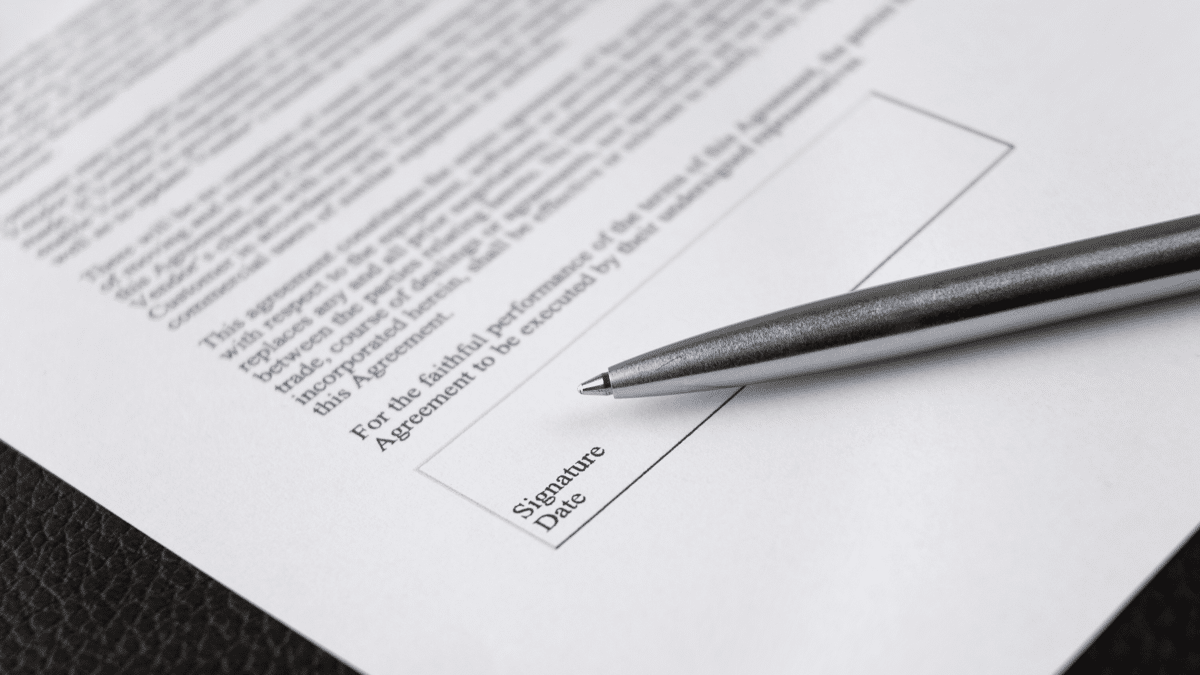In this guide
If you want to run your own self-managed super fund (SMSF), there are some administrative tasks you need to complete before you can get onto the more exciting business of investing. One of these tasks is to draw up a trust deed.
What is an SMSF trust deed?
An SMSF trust deed is a legal document that outlines how the super fund will be set up and how it will operate. In short, it states the rules governing your fund – what it can and can’t do.
An Australian SMSF must be set up as a trust and established with a trust deed that complies with Australian superannuation legislation.
A trust is a legal structure where an individual or company trustee holds assets in trust for the benefit of others (the beneficiaries).
Why is a trust deed necessary?
A super fund is a special type of trust, set up and maintained for the sole purpose of providing retirement benefits to its members (the beneficiaries). To enjoy the tax benefits of super, an SMSF trust deed must be set up correctly.
SMSFs are regulated by the Australian Taxation Office (ATO), which monitors their compliance with super legislation and can impose a range of penalties for non-compliance.
2026 SMSF calendar
Our free calendar includes due dates for important documents plus suggested dates for trustee meetings and other strategic issues for your SMSF.
"*" indicates required fields
The four essential requirements for establishing a trust are:
- A trust deed.
- An SMSF can have up to six members.
- Every member of an SMSF must also be a trustee of their fund or a director of a corporate trustee. SMSF trustees are responsible for managing the fund to ensure its compliance with Australian super legislation.
- An asset (or assets). SMSFs can be started with a nominal amount (for example $10) that is allocated to a member or members of the fund. Alternatively, the pre-existing super balances of members in other super funds (such as retail or industry funds) can be rolled into an SMSF as its initial assets.
What information is included in the deed?
Information contained in an SMSF trust deed will typically include:
- The names of the members and individual trustees (or the names of the fund’s directors if the fund has been set up with a corporate trustee structure).
- The objective of the SMSF. All Australian super funds (including SMSFs) must be set up for the sole purpose of providing retirement benefits to fund members (or to their dependants when they die).
- Rules that allow the trustees or directors to implement the fund’s investment strategy. Trustees/directors must also document an investment strategy as part of the SMSF set-up process. The trust deed should outline the specific types of investments that the trustees/directors can make.
- Rules that outline how the fund will be administered, how member benefits will be paid (as a lump sum or pension), and the circumstances in which the fund will be wound up.
Where can I get an SMSF trust deed?
If your SMSF needs are reasonably straightforward, you can purchase standard SMSF trust deeds online.
However, if your SMSF arrangements are likely to be more complex or you would value the oversight of an expert, it is advisable to hire an experienced professional to help you prepare your fund’s trust deed. This will help to ensure it complies with super legislation.
It’s also important that all trustees/directors are involved in discussions during the preparation of the deed, so there is clear agreement and understanding about how the fund will be managed right from the start.
SMSF trust deeds are not subject to stamp duty, except in the Northern Territory where a nominal fee is charged.
When do I need to update the trust deed?
Ideally, an SMSF trust deed should be written in a way that doesn’t require regular updating. However, the deed should be reviewed at least annually to ensure it’s up to date.
Here’s a checklist of the main areas that may need reviewing:

Free eBook
SMSF investing essentials
Learn the essential facts about the SMSF investment rules, how to create an investment strategy (including templates) and how to give your strategy a healthcheck.
"*" indicates required fields
- Fund changes such as adding or removing members
- Investments. Older trust deeds may not allow for less common investments such as international shares, or more basic trust deeds may not allow for investment in real property, for example, or a limited recourse loan to purchase it.
- Pensions. If your fund has members approaching retirement, check that it allows for the type of pensions they may wish to take, such as transition to retirement pensions or annuities. If your fund will have members in accumulation and pension phase, and will need to calculate exempt current pension income, the trust deed may need to allow for the segregation of assets. Learn more about SMSF pensions.
- Estate planning. A trust deed sets out what happens to a member’s benefits on their death. If a member wishes for their pension to be passed on to their dependants as a pension and not a lump sum, the trust deed needs to allow for pension reversionary benefits. It’s also generally recommended each member states their wishes for their death benefits in a binding death benefit nomination. This is separate to the trust deed, but the trust deed needs to allow for binding death benefit nominations. It also helps if it states that a trustee will follow the intentions of any member’s binding nominations. Learn more about estate planning for SMSFs.
- Changes to super legislation. A universal clause that has a provision incorporating changes to legislation impacting the governing rules of the fund can be very helpful, for example, when new types of pensions are legislated. Other changes may require more specific updating.
For example, the Transfer Balance Cap introduced in July 2017 has affected how super funds (including SMSFs) can operate. This cap is the maximum amount that can be transferred to an eligible member’s tax-free pension account and is currently $1.9 million, up from $1.6 million prior to 1 July 2021, and $1.7 million from 1 July 2021 to 30 June 2023.
SMSF trust deeds potentially need updating for this change to give trustees the power to roll back excess pension funds into their member’s accumulation accounts (if they don’t already have this power).
In addition, concessional (before tax) and non-concessional (after tax) caps on super contributions are indexed periodically. These cap changes affect the maximum amounts that SMSF members can contribute to their fund each year. The annual concessional contributions cap was increased from $27,500 to $30,000 from 1 July 2024. The annual non-concessional cap was increased from $110,000 to $120,000.
SMSF trust deeds may need updating for these changes to reflect how any excess contributions will be handled by the fund (if this isn’t already outlined in the trust deed). For example, whether they would be:
- Automatically rejected and refunded, or
- Accepted and any member will pay additional tax for exceeding the contributions cap.
What about minor updates?
A review of an SMSF trust deed may reveal minor updates that need to be made, such as typographical errors. For example, a member’s name might be spelled incorrectly (or their middle name omitted) or the deed may contain an incorrect date. A deed of variation can be used for minor updates like these, rather than drafting an updated trust deed document.
A deed of variation can highlight any simple trust deed errors along with the correct information. It should be prepared and signed by all trustees/directors for minor updates and simply attached to the existing SMSF trust deed.
How do I update my trust deed?
Updates to SMSF trust deeds (and the preparation of deeds of variation) are best handled by professionals to ensure compliance. The cost will depend on the extent of the update. Minor variations will obviously be less expensive.
As the trust deed is a legal document, the ATO stipulates that an SMSF trust deed must be written by someone who is competent to do so. This doesn’t automatically rule out writing your own deed or deed of variation, but it does mean you need to be confident that what you are writing would stand up when tested by a third party in a legal setting.
Supercharge your SMSF

"*" indicates required fields
What happens if I lose my trust deed?
SMSF trustees/directors are required to retain the original hard copy of their fund’s trust deed (and any subsequent updates or deeds of variation) while their fund is in operation and for a period of five years after the fund’s final annual tax return is submitted to the ATO. It should be kept in a secure place along with other important documents.
Government departments and courts generally won’t accept printed or digital copies, but you might consider saving a digital copy to the cloud for easy reference.
If you lose your trust deed, you should try to find it! While this is an obvious step, make sure you leave no stone unturned. For example, contact any third-party professionals that may have the original (or at least a copy of it). Those professionals could include the lawyer who helped you prepare it, your accountant or financial planner.
Finding a copy will at least help you prepare a new original and cut down the time and cost of doing so. But if you still can’t find your SMSF trust deed, prepare a new one to ensure your ongoing compliance.
The bottom line
A trust deed is a legal document you must prepare if you want to run your own SMSF. It outlines how your fund will be set up and how it will operate. The deed should be reviewed regularly by fund trustees to ensure that it’s up to date.
You should seek independent professional advice when preparing and updating your SMSF trust deed to ensure your fund’s compliance with Australian superannuation legislation. The information contained in this article is general in nature.



Leave a Reply
You must be logged in to post a comment.